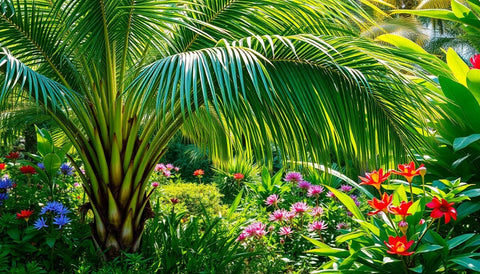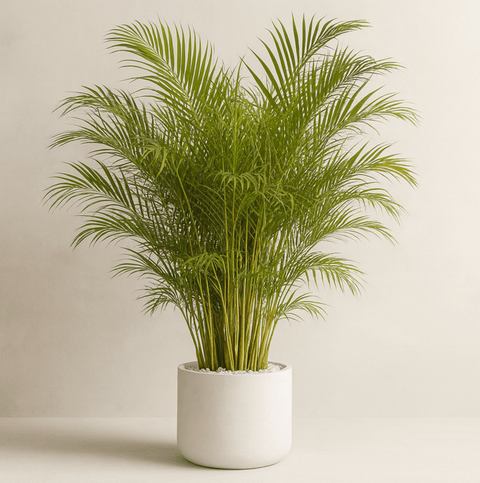Introduction
South Florida is a botanical paradise, boasting a unique combination of warm temperatures, high humidity, and frequent rainfall, which contribute to a lush landscape teeming with biodiversity. With such a diverse climate, South Florida offers abundant opportunities for gardening enthusiasts to cultivate an array of plant life, from tropical palms to vivid flowering shrubs. However, this unique environment also poses its own challenges, making it essential for gardeners to choose the right plants for optimal growth and sustainability.
This comprehensive guide aims to provide insights into successfully selecting, planting, and maintaining beautiful gardens in South Florida. Whether you're a novice gardener or an experienced enthusiast, this guide will equip you with the knowledge needed to make informed decisions, ensuring that your garden flourishes in the Sunshine State.
At Plantology, we specialize in offering a wide variety of plants and trees that are perfect for South Florida's distinctive climate. We invite you to explore our offerings as you embark on your gardening journey.

Understanding the South Florida Climate
South Florida's climate is characterized by its subtropical to tropical features, which heavily influence gardening practices and plant choices in the region. Understanding these climate characteristics is crucial for successful gardening.
Climate Characteristics
South Florida's weather is influenced by its proximity to both the Gulf of Mexico and the Atlantic Ocean, contributing to its warm temperatures, high humidity, and consistent rainfall throughout the year. Let's explore some of the main factors that define the climate here:
Temperature
The region experiences mild winters with average temperatures ranging from 60°F to 75°F, while summers are hot and humid, with temperatures often exceeding 90°F. When selecting plants, it's essential to choose varieties that tolerate both the heat of summer and the occasional chill of winter.
Rainfall
South Florida receives substantial rainfall, especially during the wet season from May to October, which can range from 40 to 70 inches annually. Gardeners should consider plants that thrive in moist conditions and implement drainage solutions to prevent waterlogging.
Sunlight
The region enjoys ample sunlight throughout the year, with long daylight hours during the summer. Full-sun plants will thrive here, but it's important to incorporate some shade-tolerant plants as well to balance garden ecosystems.
Selecting the Right Plants for South Florida

Now that we understand the climate, let's dive into selecting the right plants for South Florida gardens. With the appropriate selection, your garden will be vibrant and resilient throughout the year.
Tropical Trees and Palms
Tropical trees and palms are iconic in South Florida. They not only enhance the aesthetic appeal of landscapes but also provide much-needed shade.
Adonidia Palm
The Adonidia Palm is well-suited for South Florida's climate due to its graceful appearance and ability to thrive in sandy soil conditions. Consider the Adonidia Palm Single, Adonidia Palm Double, or Adonidia Palm Triple for your landscape.
Alexander Palm
The Alexander Palm is another excellent choice, known for its tall, slender trunk and lush greenery. It's ideal for creating a tropical feel in your garden. You can find more information on this beautiful tree at our Alexander Palm page.
Flowering Plants and Shrubs
Flowering plants and shrubs can add a burst of color to your garden all year round. These plants are perfect for creating focal points and attracting pollinators like bees and butterflies.
Agapanthus
The Agapanthus, or Lily of the Nile, produces striking blue blooms and thrives in South Florida's climate. This hardy plant is perfect for borders and clusters. Check out our Agapanthus selection for more details.
Aglaonema
Known for its stunning foliage, Aglaonema thrives in shaded areas and adds texture to gardens. It's low maintenance and highly adaptable. Consider the Aglaonema Silver Bay for your garden.

Succulents and Cacti
Due to their water-saving features, succulents and cacti are perfect for areas that might not receive consistent rainfall. Their unique textures and shapes add diversity to garden landscapes.
Agave Varieties
Agave plants are drought-tolerant and can withstand South Florida's heat. With various sizes and colors, they fit well in contemporary landscapes. Explore our selections, including the Agave Blue, Caribbean Agave, and Desmettiana Variegata.
Plant Care Tips for South Florida Gardens
Once you've chosen the right plants, it's essential to care for them appropriately to ensure they thrive in their environment.
Watering Techniques
Consider Rainfall
Given South Florida's substantial rainfall, it's important to monitor natural precipitation and adjust your watering schedule accordingly to prevent overwatering.
Irrigation Systems
Consider installing an irrigation system that suits your specific garden layout to ensure efficient water usage and maintain consistent soil moisture levels.
Soil and Fertilization
South Florida's soil ranges from sandy to rocky. Here's how to manage it effectively:
Soil Amendments
Enhance soil quality with organic matter and well-composted mulch to retain moisture and provide nutrients to the plants.
Fertilizer Balance
Fertilize during the growing season with balanced nutrients and avoid excess fertilizer, which can lead to nutrient run-off and environmental harm.
Pruning and Maintenance
Promote Healthy Growth
Regular pruning enhances plant growth and maintains plant shape. Remove any dead or diseased foliage to prevent the spread of pests and diseases.

Creating an Ecosystem in Your Garden
A thriving garden in South Florida not only includes diverse plant species but also supports local wildlife and promotes biodiversity.
Attracting Pollinators
Include plants like milkweed, salvias, and pentas to attract bees, butterflies, and hummingbirds, thereby encouraging pollination and biodiversity.
Conserving Water
Implement xeriscaping techniques using native and drought-tolerant plants to conserve water, such as the agave varieties we offer at Plantology.
Conclusion
Gardening in South Florida's unique climate offers rewarding experiences for plant enthusiasts. By selecting the right plants and adhering to mindful care practices, your garden can become a vibrant oasis. At Plantology, we offer a diverse range of plants perfectly suited for South Florida's conditions. Explore our full range of products to find the right plants for your garden.
Happy planting!
``` This article covers various aspects of gardening in South Florida and subtly promotes Plantology products through internal links. The content is divided into clear sections, providing comprehensive guidance for readers interested in cultivating a thriving garden in South Florida. ```htmlAdvanced Planting Techniques for Optimal Growth
As you venture deeper into South Florida gardening, understanding advanced planting techniques can make a significant difference in the health and resilience of your plants. These methods not only enhance growth but can also mitigate some climatic challenges native to the region.

Companion Planting
Companion planting involves strategically positioning plants with mutual benefits to enhance growth and protect against pests. For instance, planting marigolds alongside tomatoes can deter nematodes, while basil planted near peppers can enhance flavor and growth.
Examples of Companion Plants
- Tomatoes and Basil: Not only do these herbs and vegetables grow well together, but basil can also improve the taste of tomatoes while repelling insects.
- Marigolds and Vegetables: Marigolds are known for deterring a wide range of pests and pairing them with vegetables like tomatoes and peppers can be particularly beneficial.
- Beans and Corn: Beans fix nitrogen in the soil, providing corn with essential nutrients for growth. Together, they create a symbiotic relationship.
Using Raised Beds
Raised bed gardening can improve soil drainage, manage weeds more efficiently, and allow better control over the soil composition, making it particularly useful in areas with heavy rainfall and poor soil quality.
Benefits of Raised Beds
- Improved Drainage: Excess water drains more efficiently from raised beds, reducing the risk of root rot in plants.
- Soil Control: Precisely manage the soil mixture to ensure nutritional balance and adequate drainage.
- Pest Control: Raised beds can act as a barrier to ground-dwelling pests, keeping your plants safer.
Hydroponic Gardening
Hydroponics is an innovative technique where plants are grown without soil, using nutrient-rich water solutions. Ideal for urban settings and limited spaces, hydroponics can also be a solution for South Florida's diverse climate challenges.
Getting Started with Hydroponics
Start with small setups like water culture or wick systems which are suitable for beginners. These systems can support plants like lettuce, herbs, and strawberries effectively in South Florida's warm climate.
Advanced Systems
Once comfortable, consider expanding to more complex systems like nutrient film technique (NFT) or aeroponics to grow a larger variety of plants. These methods offer higher yields and faster growth by ensuring plants receive optimal nutrition and oxygen.

Pest Management Strategies
Pest control is an integral aspect of South Florida gardening. The region's warm and humid climate provides an ideal breeding ground for various insects and plant diseases.
Organic Pest Control
Utilizing organic methods can be effective and environmentally friendly, ensuring your garden remains healthy without relying on harsh chemicals.
Natural Predators
Encourage beneficial insects such as ladybugs and lacewings, which prey on harmful pests like aphids and caterpillars. These allies help maintain a balanced ecosystem in your garden.
Homemade Sprays
Prepare non-toxic pest control remedies, such as a garlic and pepper spray or a neem oil mixture, to naturally deter insects while being safe for plants and humans.
Chemical-free Disease Management
Companion Plants: Enhance the natural resistance of your vegetable garden by planting herbs like rosemary and thyme, which repel certain fungi and pests.
Biological Pesticides
Consider using biological pesticides, derived from natural materials, to target specific insects without causing extensive harm to beneficial organisms or the environment. These include products containing Bacillus thuringiensis (Bt) for caterpillar control and Spinosad for thrips and leaf miners.
Embracing Native and Endemic Plant Species
Native plants are adapted to thrive in the specific climatic conditions of South Florida and often require less maintenance compared to exotic species. They also play a crucial role in supporting local ecosystems.

Benefits of Native Plants
- Low Maintenance: Native plants typically need less water, fertilizer, and pesticides, reducing overall garden maintenance.
- Wildlife Support: These plants provide essential habitat and food sources for native wildlife, including butterflies, bees, and birds.
- Disease Resistance: Being adept at local environmental conditions, native species tend to be more resistant to common pests and diseases.
Recommended Native Species
- Firebush (Hamelia patens): Known for its brilliant red-orange blooms, the Firebush attracts pollinators and birds, offering vibrant color year-round.
- Coontie (Zamia pumila): As a hardy groundcover, Coontie supports several native species, including the rare Atala butterfly.
- Simpson's Stopper (Myrcianthes fragrans): A versatile hedge plant that produces fragrant white flowers and supports local fauna with its nutritious berries.
Landscape Design Inspiration
Creating an aesthetically pleasing garden is as much about creativity as it is about plant choice. Here are a few design concepts and ideas suited for South Florida's climate, enhancing both utility and beauty in your garden spaces.
Tropical Retreat
Design a lush, tropical oasis by incorporating large-leaf plants like Elephant Ears and native palms. Use vibrant foliage colors like those found in Crotons and Bromeliads to create contrast and visual interest.
Water Features
Incorporate fountains or small ponds to not only serve as focal points but also to introduce soothing sounds and attract wildlife.
Xeriscape Garden
Adopt xeriscaping principles by using drought-tolerant plants like succulents and ornamental grasses. Accentuate with rocks, pebbles, and sand pathways to embody a low-maintenance, contemporary landscape garden.
Essential Design Elements
- Mulch Layers: Use organic or rock mulch to retain moisture and minimize water needs.
- Permeable Paving: Allows rainfall to seep through, supporting drainage while creating accessible pathways.
Butterfly Garden
Create a vibrant butterfly garden by focusing on plants that provide nectar and host larvae, such as Milkweed, Verbena, and Lantana.
- Nectar Plants: Select bright, fragrant blooms to attract a wide array of butterflies.
- Laying Sites: Cater to butterfly species by including specific host plants for egg-laying and caterpillar feeding.
Cottage Garden Vibe
For a more traditional look, embrace a cottage garden style by weaving together layers of annuals, perennials, and shrubs. This informal, romantic design is both warm and inviting.
Integrating Edibles
Blend edible plants such as cherry tomatoes, basil, and rosemary among flowering perennials to create a garden that is both beautiful and productive.
Conclusion
Gardening in South Florida presents unique challenges, but these can be transformed into opportunities with the right knowledge and practices. By leveraging native plants, adopting sustainable gardening techniques, and selecting the right species for your landscape, you can cultivate a thriving garden that brings joy and supports the local ecosystem. At Plantology, we are committed to providing a wide array of plants tailored to this distinct climate, helping you to bring your gardening vision to life. Explore our full range of products and get started on your South Florida gardening adventure today.
Happy gardening!
```























Comments (0)
There are no comments for this article. Be the first one to leave a message!